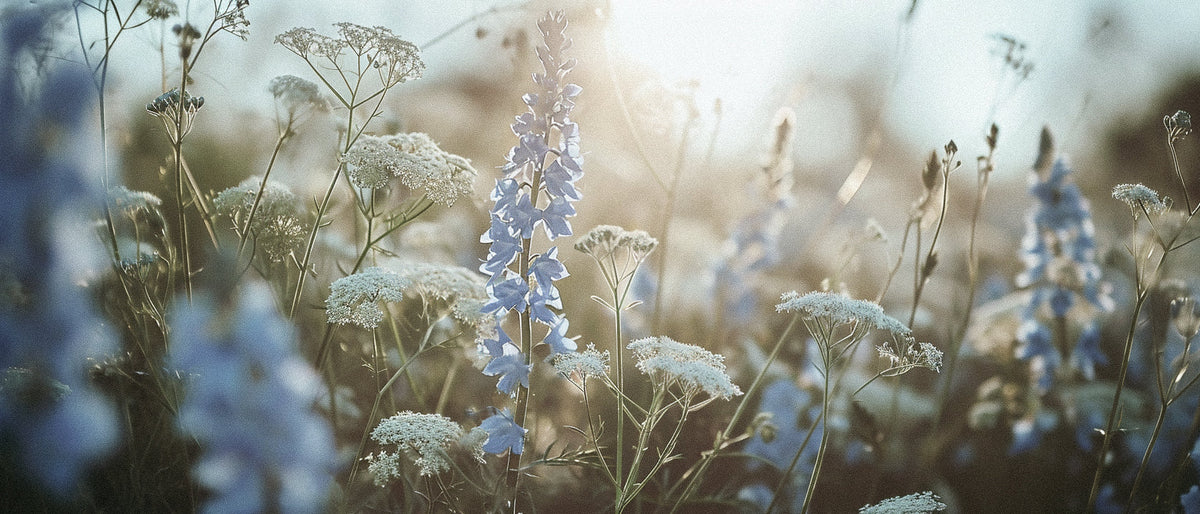
The Perfumer's Green Laboratory: 5 Sustainable Ingredients Defining Modern Eco-Luxury Fragrances
|
|
Time to read 12 min


|
|
Time to read 12 min
Ever noticed how a perfume that smells heavenly on your friend turns into something completely different on your skin? It’s not magic—it’s chemistry! As someone who’s explored countless natural perfumes and sustainable fragrances, I’ve discovered that the relationship between your skin and a fragrance is like a dance—unique, personal, and ever-evolving.
The world of niche fragrance has been transformed by a green revolution, with sustainability becoming the new luxury. Natural perfume isn’t just a trend—it’s redefining how we think about scent, quality, and environmental responsibility. Let’s dive into the fascinating world of sustainable ingredients that are shaping the future of eco-luxury fragrances.
The luxury fragrance market is experiencing a remarkable transformation. No longer satisfied with just smelling good, today’s conscious consumers want to know what’s in their bottle and how it got there. The numbers tell a compelling story: the natural fragrance market is projected to grow from $9.76 billion in 2024 to a staggering $23.39 billion by 2033, with a robust CAGR of 10.20%.
This isn’t just about smelling nice—it’s about making choices that align with our values. The distinctive character of niche perfume comes from unique ingredient combinations and higher concentration of natural materials. Unlike mass-market fragrances, natural perfume evolves uniquely on each person’s skin, creating a truly personal scent experience.
But what exactly makes a fragrance “natural” or “sustainable”? It goes beyond just using plant-based ingredients. True sustainability in perfumery encompasses ethical sourcing, responsible farming practices, fair labor conditions, and environmentally friendly production methods.
Many natural perfume brands have built their reputation on ethical sourcing and transparency. They’re not just selling a scent—they’re selling a philosophy, a commitment to both people and planet. This holistic approach is what sets apart genuine eco-luxury fragrances from those merely jumping on the green bandwagon.
The world of niche fragrance offers unique scent experiences that can’t be found in mainstream perfumery. What makes these fragrances special isn’t just their exclusivity—it’s their commitment to quality, craftsmanship, and increasingly, sustainability.
Creating a natural perfume requires a deep understanding of how botanical ingredients interact with each other. Master perfumers are like alchemists, transforming raw materials into complex, evolving scent stories. Each bottle of handcrafted perfume represents hours of careful blending and testing.
Sustainability has become a defining characteristic of modern niche fragrance houses. They’re pioneering new approaches to ingredient sourcing, production methods, and even packaging. The best natural perfume brands balance artistry with sustainability in every creation.
Let’s explore five remarkable sustainable ingredients that are defining the future of eco-luxury fragrances. Each has its own unique story, scent profile, and environmental benefits.
Bergamot (Citrus bergamia) is that bright, uplifting note you might recognize from Earl Grey tea. But in the world of natural perfume, it’s so much more—it’s a cornerstone of sustainable luxury.
In the sun-drenched region of Calabria, Italy, bergamot has been cultivated for centuries using traditional methods that have stood the test of time. What makes this approach sustainable? It’s all about harmony with the local ecosystem and community.
The complex chemistry of essential oils creates depth and character in natural perfumes, and bergamot oil is particularly prized for its unique composition. It contains over 350 different compounds, creating a complex scent profile that can’t be replicated synthetically. This complexity is why bergamot is featured in approximately 50% of all fine fragrances.
Traditional bergamot cultivation employs several sustainable practices:
Hand-harvesting techniques that have been passed down through generations
Organic farming methods that avoid harmful pesticides
Water conservation strategies essential in the Mediterranean climate
Support for local farming communities, providing stable employment
The growing demand for non-toxic perfume has pushed brands to be more transparent about their ingredients, and bergamot is often highlighted as a star sustainable component. Its bright, complex aroma provides the perfect top note in many natural perfume compositions.
What makes bergamot particularly valuable in sustainable perfumery is its versatility. It plays well with other notes, from floral to woody, making it an essential component in a perfumer’s palette. The distinctive character of niche perfume often relies on such versatile ingredients that can bridge different scent families.
Many perfume enthusiasts are turning to niche fragrance collections for their authenticity and quality, and bergamot-forward scents are often gateway fragrances for those new to natural perfumery. Its familiar yet sophisticated profile makes it accessible while still feeling special.
If bergamot represents the bright, sparkling side of natural perfume, vetiver embodies its grounding, earthy soul. This remarkable grass (Chrysopogon zizanioides) is not just a beautiful fragrance ingredient—it’s a powerful environmental ally.
The market for natural perfume has seen exponential growth as consumers become more environmentally conscious, and vetiver is at the forefront of this movement. Unlike many crops that deplete soil, vetiver actually improves it. Its massive root system, which can grow up to 15 feet deep, performs several ecological services:
Prevents soil erosion on steep slopes
Sequesters carbon deep in the soil
Filters water and removes toxins
Creates natural barriers against flooding
Sustainable harvesting practices ensure that essential oils maintain their quality while protecting natural resources. When vetiver is harvested for perfumery, only the roots are taken, allowing the plant to regenerate. This makes it a truly renewable resource.
In Haiti, which produces some of the world’s finest vetiver oil, sustainable cultivation programs are helping to restore degraded landscapes while providing stable income for farming communities. The art of handcrafted perfume has been passed down through generations in many perfume houses, and vetiver harvesting techniques are similarly preserved as cultural heritage.
The distinctive smoky, woody, and slightly earthy aroma of vetiver essential oil adds depth and longevity to fragrances. It’s often used as a base note, providing the foundation upon which other scent elements are built. Investing in niche perfume means supporting artisanal craftsmanship and sustainable practices, particularly when it features ethically sourced ingredients like vetiver.
Creating a non-toxic perfume requires careful selection of natural botanical extracts, and vetiver is prized for its low allergenic potential. It’s also remarkably versatile, pairing beautifully with citrus, floral, and woody notes alike.
What’s particularly fascinating about vetiver is how its scent profile varies depending on where and how it’s grown—much like wine, it expresses terroir. Haitian vetiver tends to be smokier, while Indonesian varieties often have more earthy, chocolate-like nuances. This natural variation gives perfumers a palette of options even within a single ingredient.
Is there any scent more iconic than rose? Probably not. But the rose used in natural perfume is worlds away from the synthetic approximations found in mass-market fragrances. The story behind each niche perfume often reflects the perfumer’s personal journey and values, and roses tell a particularly compelling sustainability story.
In the Valley of Roses in Bulgaria, a region famous for its rose production, traditional farming methods are being combined with modern sustainable practices. The result is a rose oil that’s not only exquisite in fragrance but also environmentally responsible.
Leading natural perfume brands are pioneering new extraction techniques that preserve the integrity of botanical ingredients. Traditional steam distillation of roses requires approximately 3,000 kilograms of petals to produce just one kilogram of essential oil. This makes rose oil one of the most precious ingredients in perfumery—and one worth protecting through sustainable practices.
Sustainable rose cultivation includes:
Organic farming methods that eliminate synthetic pesticides and fertilizers
Intercropping with companion plants that naturally deter pests
Hand-harvesting during the early morning hours when oil content is highest
Support for local communities through fair labor practices
The complex chemistry of rose oil—containing over 300 different compounds—creates a depth that synthetic alternatives simply cannot match. This complexity is why rose remains a cornerstone of fine perfumery despite its high cost.
Many consumers switch to non-toxic perfume after experiencing sensitivities to synthetic fragrances, and natural rose oil is generally well-tolerated even by sensitive individuals. Its therapeutic properties, including stress reduction and mood enhancement, add another dimension to its appeal in natural perfumery.
What makes rose particularly valuable in sustainable niche fragrance is its biodiversity impact. Rose fields support diverse ecosystems, providing habitat for beneficial insects and pollinators. Some innovative rose farms are even incorporating beekeeping alongside rose cultivation, creating mutually beneficial systems.
Small-batch, handcrafted perfume allows for greater attention to detail and quality control, which is essential when working with precious ingredients like rose. The difference between mass-produced synthetic rose scents and a true rose essential oil in natural perfume is immediately apparent—one is a flat approximation, while the other is a living, breathing scent experience that evolves on the skin.
Few materials in perfumery have faced as many sustainability challenges as sandalwood. Once overharvested to near extinction in India, this precious wood has become a powerful example of how sustainable practices can save an endangered resource.
The distinctive character of niche perfume often comes from ingredients with rich cultural histories, and sandalwood has been used in religious ceremonies and perfumery for thousands of years. Its warm, creamy, woody aroma creates a perfect base note that anchors and extends the life of a fragrance.
Australian sandalwood (Santalum spicatum) has emerged as a sustainable alternative to the endangered Indian species. The story is remarkable:
Long-term plantation planning with 15-25 year growth cycles
Partnerships with Indigenous communities who have traditional knowledge of the species
Careful harvesting that allows for regeneration
Certification programs ensuring ethical practices throughout the supply chain
Creating a natural perfume with sandalwood requires patience—the trees must grow for at least 15 years before harvesting. This long-term perspective is at the heart of true sustainability. The best natural perfume brands balance immediate business needs with long-term environmental stewardship.
The complex chemistry of sandalwood essential oil creates a scent that’s simultaneously warm, creamy, woody, and slightly sweet. It contains compounds called santalols that not only contribute to its distinctive aroma but also provide skin benefits, making it doubly valuable in natural perfumery.
Many perfume enthusiasts are turning to niche fragrance collections that feature sustainable sandalwood as an alternative to mass-market fragrances that may use synthetic substitutes or unsustainably sourced materials. The difference is noticeable—natural sandalwood has a depth and complexity that evolves on the skin over many hours.
What makes sustainable sandalwood particularly valuable is its role in carbon sequestration. These slow-growing trees capture and store significant amounts of carbon over their long lifespans, making them allies in the fight against climate change. Investing in niche perfume featuring sustainable sandalwood means supporting these important environmental benefits.
The growing demand for non-toxic perfume has created new opportunities for sustainable sandalwood producers. As consumers become more educated about ingredients, they’re willing to pay premium prices for ethically sourced materials with proven provenance.
When I think of lavender fields stretching to the horizon in Provence, France, I’m reminded that some of the most beautiful ingredients in natural perfume are also among the most sustainable. The market for natural perfume has seen exponential growth as consumers become more environmentally conscious, and lavender is often their first introduction to botanical fragrances.
Unlike many crops that require intensive irrigation, lavender is naturally drought-resistant, making it well-suited to the changing climate conditions in its traditional growing regions. Sustainable lavender cultivation includes:
Organic farming methods that eliminate synthetic chemicals
Water conservation techniques including drought-resistant varietals
Support for pollinator populations, particularly bees
Innovative distillation methods that reduce energy consumption
The complex chemistry of lavender essential oil creates a scent profile that’s far more sophisticated than many people realize. Beyond the familiar floral notes, it contains woody, herbaceous, and even slightly sweet facets that skilled perfumers can emphasize or downplay depending on the composition.
Leading natural perfume brands are pioneering new extraction techniques that preserve the integrity of botanical ingredients like lavender. Traditional steam distillation is being refined with energy-efficient equipment, and some producers are exploring CO2 extraction, which operates at lower temperatures and preserves more of the plant’s delicate compounds.
What makes lavender particularly valuable in sustainable perfumery is its versatility. It works beautifully as a bridge note, connecting citrus top notes with woody base notes. The distinctive character of niche perfume often relies on such versatile ingredients that can create harmony between diverse scent elements.
Many consumers switch to non-toxic perfume after experiencing sensitivities to synthetic fragrances, and lavender is generally well-tolerated even by those with sensitive skin. Its calming properties add another dimension to its appeal in natural perfumery.
Small-batch, handcrafted perfume allows perfumers to work with lavender varieties from different regions, each with its own unique scent profile. High-altitude lavender tends to be more herbaceous and camphoraceous, while lavender grown at lower elevations often has sweeter, more floral characteristics.
The story behind each niche perfume often reflects the perfumer’s personal journey and values, and many independent perfumers have deep connections to the lavender-growing regions that supply their materials. These relationships ensure fair prices for farmers and maintain the economic viability of traditional lavender cultivation.
Creating truly sustainable natural perfume isn’t without challenges. The world of niche fragrance is constantly evolving to address these issues through innovation and commitment.
One of the biggest challenges is ingredient verification. How can brands ensure that materials are truly sustainably sourced? This is where technology is making a difference:
Blockchain technology is being implemented to track ingredients from farm to bottle
DNA testing can verify botanical species and origins
Direct relationships between perfumers and farmers create transparency
The growing demand for non-toxic perfume has pushed brands to be more transparent about their ingredients, but this creates another challenge: how to create complex, long-lasting fragrances without synthetic fixatives. Innovative natural perfumers are finding solutions:
Using naturally long-lasting base notes like sustainably sourced ambrette seed and beeswax
Developing higher-concentration formulas that extend wear time
Creating layering systems that allow consumers to refresh their scent throughout the day
Many natural perfume brands have built their reputation on addressing these challenges head-on. They’re not just creating beautiful scents—they’re pioneering new approaches to sustainability that may eventually influence the broader fragrance industry.
The distinctive character of niche perfume comes from this willingness to innovate and experiment. While mass-market brands might be constrained by cost considerations and marketing timelines, independent perfumers can take risks and pursue their sustainability vision without compromise.
What’s next for sustainable ingredients in natural perfume? The future looks promising, with several emerging trends:
Bioengineered Sustainable Ingredients : Scientists are developing ways to create fragrance compounds through fermentation rather than extraction, potentially reducing pressure on natural resources while maintaining natural origins.
Carbon-Negative Fragrances : Some pioneering niche fragrance houses are going beyond carbon neutrality to create perfumes that actually have a net positive impact on the environment through regenerative sourcing practices.
Circular Packaging Solutions : Innovative refill systems, biodegradable materials, and plastic-free packaging are becoming the new standard in eco-luxury fragrances.
Water Conservation : New extraction technologies that use significantly less water are being developed, addressing one of perfumery’s hidden environmental impacts.
The market for natural perfume has seen exponential growth as consumers become more environmentally conscious, and this trend shows no signs of slowing. As more people discover the depth, complexity, and personal nature of natural fragrances, demand will continue to increase.
Many perfume enthusiasts are turning to niche fragrance collections for their authenticity, quality, and environmental credentials. They’re discovering that sustainable doesn’t mean sacrificing luxury—in fact, true sustainability is becoming the ultimate luxury.
The journey through these five sustainable ingredients reveals something important: natural perfume isn’t just about smelling good—it’s about doing good. Each time you choose a fragrance featuring ethically sourced bergamot, vetiver, rose, sandalwood, or lavender, you’re supporting sustainable agriculture, traditional knowledge, and environmental stewardship.
The distinctive character of niche fragrance comes from this commitment to quality and sustainability. It’s about creating scents with integrity—fragrances that tell honest stories about their origins and impact.
So next time you’re exploring the world of fragrance, take a moment to look beyond the beautiful bottle and marketing claims. Ask about the ingredients, their sources, and the brand’s sustainability commitments. Your choices as a consumer have power, and the future of perfumery—like the dance between skin and scent—is something we create together.
Grand View Research. (2023). Luxury Perfume Market Size Report, 2030. https://www.grandviewresearch.com/press-release/global-luxury-perfume-market
Emergen Research. (2023). Natural Fragrance Market By Product Type, By Application, By Distribution Channel, By Region, and Forecast to 2033. https://www.emergenresearch.com/industry-report/natural-fragrance-market
International Fragrance Association. (2023). IFRA Standards. https://ifrafragrance.org/standards/ifra-standards
Environmental Protection Agency. (2022). EPA Safer Choice Standard. https://www.epa.gov/saferchoice/standard
Sustainable Packaging Coalition. (2023). How2Recycle Program for Beauty Products. https://how2recycle.info/
Journal of Agricultural and Food Chemistry. (2022). Chemical Composition and Biological Activities of Essential Oils of Bergamot (Citrus bergamia). American Chemical Society.
International Journal of Environmental Research and Public Health. (2021). Vetiver Grass: A Sustainable Solution for Soil and Water Conservation. MDPI.
Journal of Essential Oil Research. (2023). Comparative Study of Rose Oil Composition from Organic and Conventional Cultivation Methods. Taylor & Francis.
Forest Ecology and Management. (2022). Sustainable Management of Sandalwood: Lessons from Australia. Elsevier.
Frontiers in Plant Science. (2023). Drought Resistance Mechanisms in Lavender Cultivation: Implications for Sustainable Agriculture in Changing Climate Conditions. Frontiers.